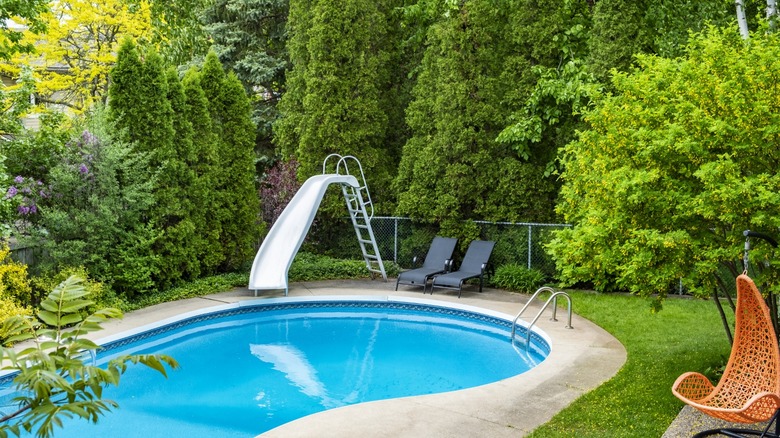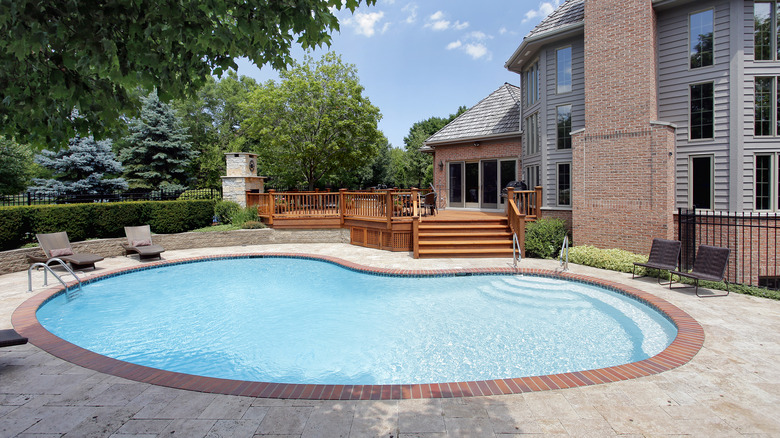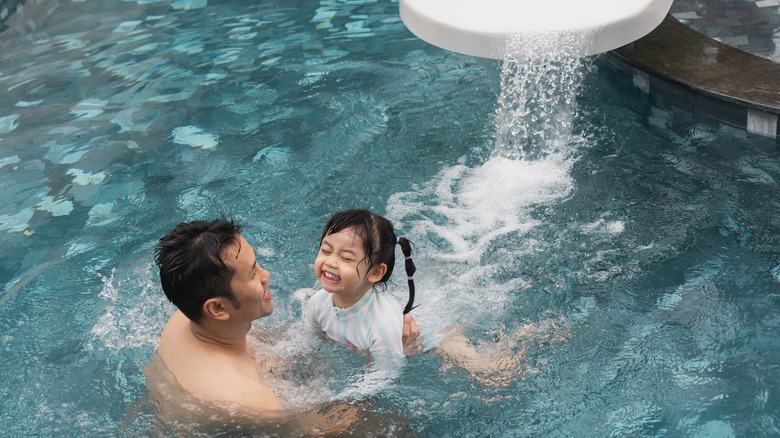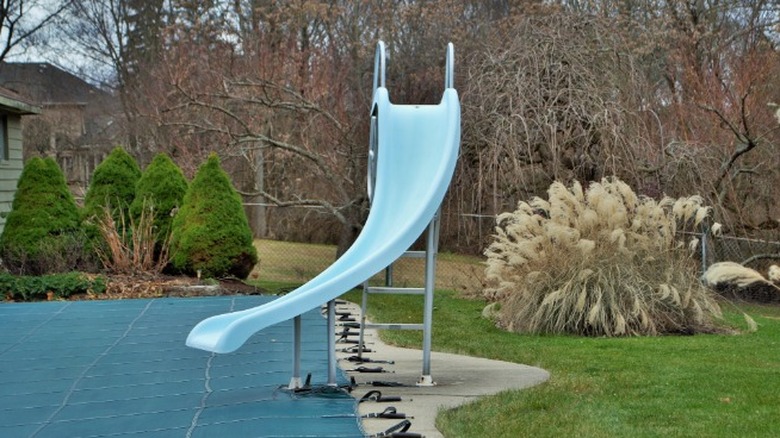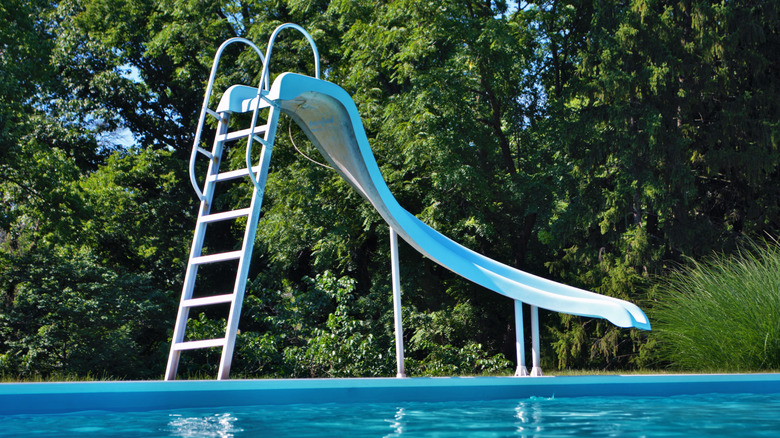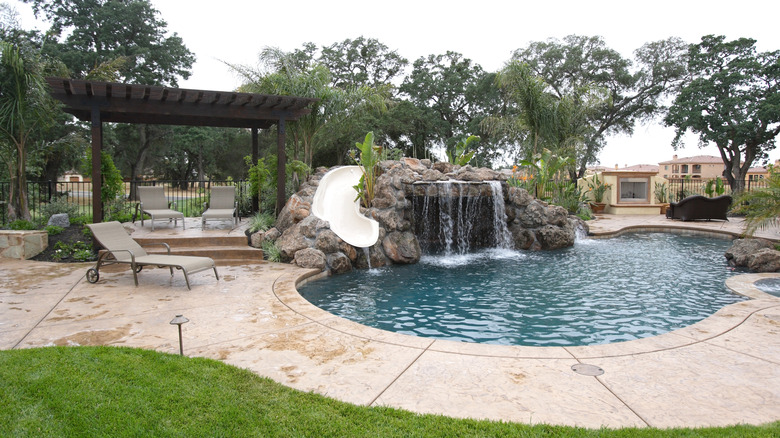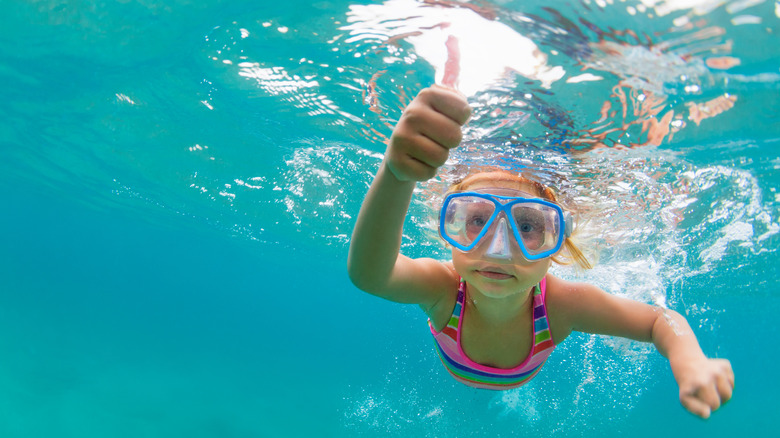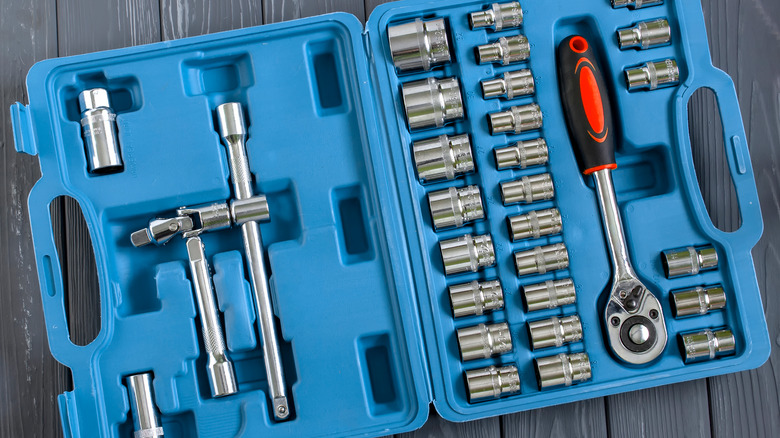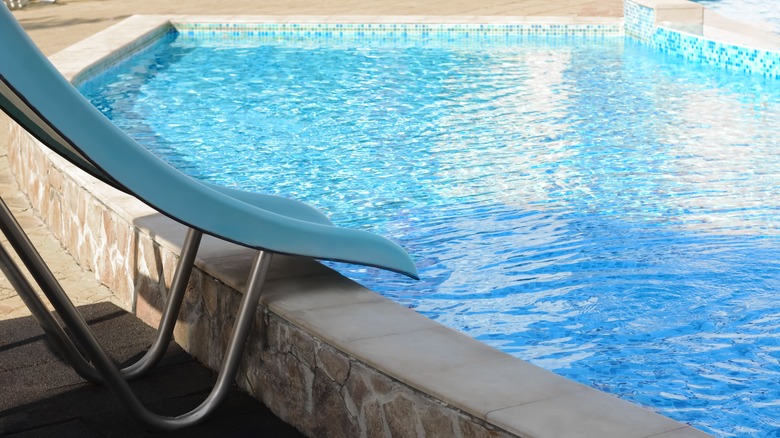What You Need To Know Before Getting A Pool Slide
Few things feel better on a hot day than enjoying a cool, refreshing pool. If you already have your own inground pool, you might want to enhance your swimming experience with additional features. According to NBWS, there are many different options. From waterfalls to spas, you can create a backyard oasis. Or, if you have kids or perhaps grandkids, why not add a pool slide for added fun? Plus, slides can be enjoyed by adults, as well! So if you're considering putting one in — you're in the right place.
You'll have to consider the shape of slide you'd like, the age of the users, and the best area of the pool to have it installed. Of course, your budget, insurance policy, and additional safety needs are other factors to think about. You'll also need to decide whether to hire someone to install the slide or tackle it yourself. Keep reading for all of the details you need to know before taking the plunge and getting a pool slide.
Make sure you have the right size requirements
Making sure you have the right size requirements is more than just knowing you have the deck space. According to Millenium Pool, you'll also need room inside the pool as well as outside. For the deck area, generally, a 7 by 15-foot area offers enough space to accommodate a slide without it getting in the way. Plan on placing it in an area where it will impede foot traffic as little as possible. Plus, you want to have plenty of space for those waiting to slide to line up. If possible, select a shaded spot where those waiting and the surface of the slide can stay cooler.
A good rule of thumb is to place your slide on the far side or corner of the pool, away from where people tend to hang out. Not only does this allow for a better view, but it also prevents loungers from getting splashed by those coming down the slide. It also minimizes the number of people that need to navigate around the slide when moving about the pool deck.
Keep in mind the slide will need enough room in front, as well as enough water depth below. This optimal depth can be determined by the slope of the slide, the manufacturer's recommendations, and the swimming abilities of its users. If the depth of your pool varies in different areas, this may dictate where you need to install the slide. You'll also want to make sure there are steps or a ladder nearby to easily exit the pool after riding down.
Know the safety regulations
Another huge thing to know about pool slides is the safety regulations, per S.R. Smith. It runs beyond the scope of simply having smart safety rules. There are certain things that are actual federal safety standards for pool slides, which are non-negotiable. If you're planning to DIY with this, it's crucial that you know them. The U.S. Government established the CPSC (Consumer Product Safety Commission) to evaluate and enforce safety standards for products that could otherwise result in harm. Never purchase a pool slide that doesn't come with a Certificate of Conformity, and isn't labeled as CPSC compliant. Doing this ensures that the manufacturer has performed all the important safety tests for meeting these federal regulations. Additionally, the installation must be performed up to standard, which is going to be detailed in the instructions from the manufacturer.
Besides federal standards, there are some common safety rules that should be followed and posted somewhere guests can see them. Rules for safety should always be strictly enforced by pool owners. Important safety rules include only allowing one person on the slide at a time, and making sure no one is in the pool in front of the slide before descending (via Life Saver Pool Fence). There should be no horseplay on or near the slide, and no one should attempt to go down the slide backward or head first. Accidents can occur if these rules are broken, and an adult should always be present to supervise and ensure they are followed.
Know the care and maintenance involved
Before shopping for a pool slide, it's also important to know what kind of maintenance is involved (via Sunplay). Some of this will depend on the material your slide is made from, and whether or not the slide has the option of running water while in use. In any case, you should at least perform an annual cleaning and inspection of your pool slide. Keeping it clean is fairly easy and can be done more often with a mild, non-abrasive cleaner and a soft cloth. No matter what material your slide is made from, it'll be important to maintain it properly to maximize its lifespan.
It's also going to be important to fix any repairs on the pool slide as soon as they appear. Some common issues can be scratches, cracks, leaks in the water supply, rust, and worn tread on the steps. Believe it or not, you can repair most any of these things yourself. For cracks in acrylic slides, all you need is a plastic welder and PE plastic, or some gel gloss or plastic polish. Regardless of the material, you have to treat them right away, because if you don't, the slide can quickly become unusable. Also, any tread pads that wear off the steps and causes them to be slippery should be replaced right away. You should also regularly tighten bolts on both the slide and steps and watch for rust or corrosion.
Decide on a design
According to Premier Pools & Spas, there are three main design types of pool slides, unless of course, you go completely custom. The first type is called the Straight Leg slide, probably the most common in smaller pools, and can be enjoyed by a variety of riders. These are typically about can be 8 to 12 feet tall, and are straight at the top with a wide curve at the bottom. The ladder to get to the top can be either an open or closed design, with the closed version being safer for younger children. The next type is called the Molded Pool Slide Leg, which is known to have a dramatic curve and a steeper incline, for a faster and more exhilarating ride. The slide can curve to either slide before riders hit the water depending on the ideal layout.
The last type is called the Elephant Leg, but there are two designs in this category. The first is called G-Force and it's usually about nine feet tall and is curvy like a snake. Riders enjoy winding down the spiraling slide before dropping into the water. The second is the Stream design and it can be an impressive 14 feet tall. It has a similar shape to the Molded Leg design. However, this option is designed to be steeper at the top of the slide, giving riders an early boost in acceleration as they head down into the curve. This makes it an awesome choice for older kiddos and adults, typically in spacious pool setups.
Know the different materials
Of course, there are also different kinds of materials pool slides can be made out of. Today, most are either fiberglass gelcoat or a type of molded plastic called polyethylene (via S.R. Smith). Both of these two modern materials have a lovely finish and are highly durable to stand up to rugged use. They're made to resist rust and won't fade in the sun, two must-have features for a pool environment. Usually, they come in white, blue, beige, and green. These solids typically fit seamlessly into a backyard pool aesthetic. Others are also made to look like other earthy materials, like stone for a more natural appearance.
According to Sunplay, both of these surface materials can be easily cleaned with a soft, clean cloth and common household cleaners like Windex or Fantastik. You can also use these cleaners to wipe down aluminum ladders. Of course, you don't want to get any of this cleaning solution in the pool, or it can change the pH balance of the water.
Is your pool deep enough?
According to My Perfect Pool, it's important to have the right depth for the right pool slide. The recommended depth varies based on a number of factors. First, how old are the slide users, and how is the slide designed? Are you adding a super steep slide designed to plummet adults and older kids into the water? Then, the pool may need to be at least 10 feet deep for safety reasons. But, if you have a smaller slide with a minimal slope that will be used by younger kids, you may only need about two feet of water to be safe. Overall, many pool specialists recommend about three to four feet of water when installing an average-sized slide.
But water depth isn't the only consideration. You'll also need enough space around the front of the slide. This area, called the water envelope, is the space where riders will land as they come off the slide. You'll want to make sure this space is adequate so riders don't land on pool ledges, steps, or other obstacles. You'll also want there to be enough space in the pool area for other swimmers to avoid this space. Keep in mind, the larger and faster the slide, the bigger your water envelope will need to be.
Other important considerations
There are a few more details to consider regarding your pool slide, per Aquascapes Pools. The first thing is to check with your homeowners' association, if you have one, to make sure there aren't any restrictions against having a pool slide. You may be allowed to put one in, but there may be specific guidelines you'll need to follow, such as color or height requirements.
You'll also want to figure out how you're going to keep the slide wet while you're using it. Water is important so that it stays lubricated, and so the people using it don't get burns from friction or the sun. Of course, a standard garden hose can be used to periodically spray the slide. However, this is less than ideal as the tap water will run off and dilute your treated pool water. The best option is a pump system that moves treated water from the pool through an integrated hose to the top of the slide. This can be installed by a contractor or savvy DIYer with plumbing skills. Not only will this keep your pool's chemistry in balance, but it's a low-fuss and more attractive way to keep your slide slick.
Know the costs involved
Of course, one of the main things you'll need to know is the cost factor. Adding a slide can be cheaper and easier when you are first having your pool installed. According to PoolContractor.com, the cost of a slide itself averages between $1,000 and $3,500. It's also a feature you can add afterward and when you tack on installation, the total cost ends up being around $4,000. While the maintenance is a minimal ongoing cost, be prepared to purchase any repair materials if needed in the future.
So, why are these seemingly simple slides so expensive? Well, according to Refresh Outdoors, the main reason is that they have to be built especially to withstand the elements. The special materials involved in the process can be expensive, but it pays to get a good-quality slide so it doesn't break or degrade over time. Weather can be hard on pool slides, and if it isn't made from quality material they can crack or split. As with most things, you get what you pay for. So, if you'd like a well-made and enjoyable slide with a smooth ride, you'll want to invest in quality and a great design.
Can you DIY?
According to In The Swim, you can install a pool slide yourself if you're looking to save on installation costs. Of course, the slide will be heavy and awkward to handle so enlist a friend or neighbor to help. Fortunately, the entire process only takes about four to eight hours, making it a doable one-day project.
First, you'll want to look at your slide's installation instructions and gather the necessary tools. Many times, these are common tools like socket wrenches and screwdrivers. Then, before you get started, take everything out of the packaging and inventory the slide parts. You should also double-check the slide measurements and ensure they are correct for the installation area. Follow the instructions to assemble the slide before setting it into place on the pool deck. Make sure everything is aligned correctly and the overhang is adequate, then securely bolt it into place. Install your water line per the manufacturer's instructions and test the flow. Be sure to double-check the stability of the overall slide and that each fastener is tightened before use.
Make sure your homeowners insurance covers pool accidents
According to PoolContractor.com, one of the ongoing costs of a pool slide is considering the changes you'll need to make to your homeowners' insurance. With this addition comes extra risk, and in turn, more liability coverage will likely be needed. Check with your agent for exact costs, but on average, it will cost an extra $1,000 a year.
As Bank Rate explains, your homeowners' insurance policy includes liability coverage should someone get injured in the pool. One additional step you can take is getting a personal umbrella policy to cover anything that exceeds this coverage. Your carrier may also need you to carry a rider policy to include the slide. There is a lot of liability involved with entertaining guests when you have a pool, and additions like a slide can increase the likelihood of accidents. Since all insurance providers are different, it's definitely something you'll want to research to compare costs and coverage.
